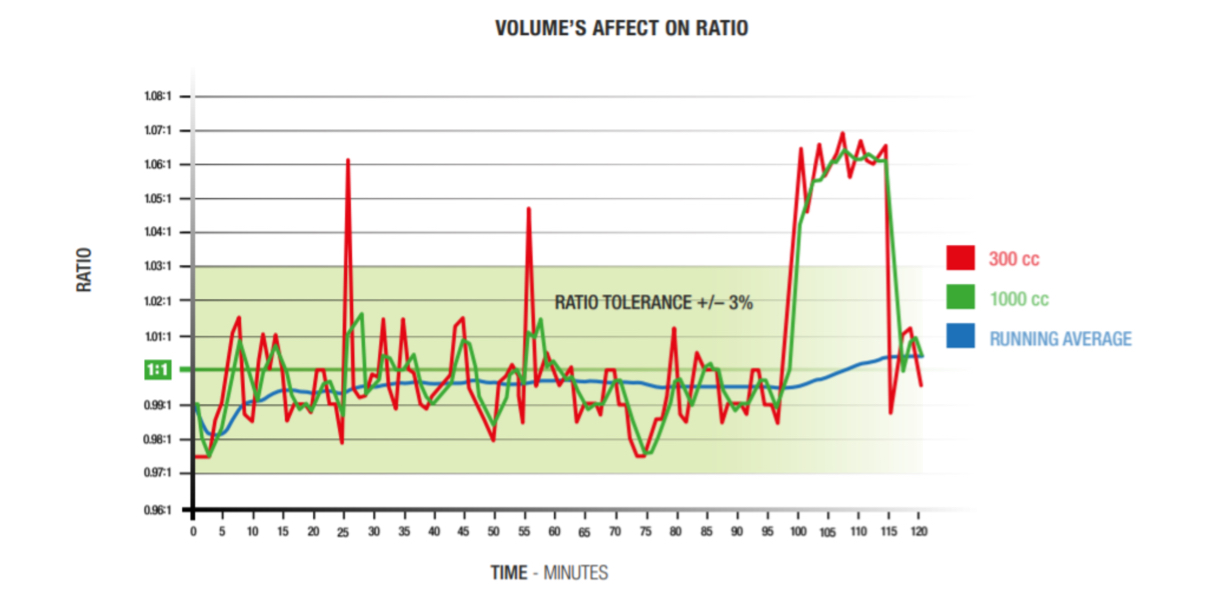At what ratio variance will the electric Reactors shut off?
Automatic ratio variance detection ensures good spraying results. But how is ratio variance calculated?
Most foam and polyurea systems require a 1:1 mixing ratio to obtain a perfect spray result. When the ratio variance exceeds the tolerance boundaries, an alarm will be activated, shutting down the system. But at what ratio variance will the Reactor shut off and how is it calculated?
Effective spray foam and polyurea systems have the ability to heat and pressurize the materials and use a robust mixing method. To ensure a good spray result, most chemistries require a 1:1 mixing ratio. When the volume of one of the materials is higher than the volume of the other, the mix will be “off ratio”, potentially resulting in bad spray results.
To avoid bad spray results, the Graco Reactor 2 Elite will alert the operator and automatically shut off the machine when the ratio variance exceeds certain tolerance boundaries.
What causes off-ratio issues?
It is important to understand the different causes of off-ratio issues, also called single-point variables:
- Air in the fluid stream
- An undersized feed pump
- Poor material feed to the proportioner
- Proportioner pump issues
- Fluid leaks
- Fluid restriction in heated hose or spray gun
The goal is to monitor for each of these variables and shut the Reactor down if one is detected, preventing off-ratio foam or polyurea from being sprayed. The operator can then make the necessary updates or perform the necessary maintenance to eliminate the issue causing the off-ratio condition.
How flow meters help to detect off-ratio issues
Flow meters can detect off-ratio issues related to the proportioner pumps, air in the feed lines/system and some fluid leaks. They provide an additional level of ratio assurance protection to the system. Flow meters have the ability to measure, monitor, and record true volumes of the A and B materials. By knowing the true volumes dispensed, this data can be made available to the customer.
How ratio is calculated
Ratio is calculated over a certain volume of material. Using a volume which is too small may cause undesired false alarms and using a volume which is too large may mask real ratio issues. Some competitor equipment calculates ratio by using a running average of the total amount of chemical dispensed. This can lead to masked real-time ratio issues, resulting in bad spray results.
At Graco we calculate ratio using a small averaging volume, 1000 cc’s, and constantly recalculating ratio on a rolling basis. Constantly refreshing the real-time ratio based on only the most recent small volume of material makes determination of the current ratio very accurate.
Why Graco calculates ratio using a small averaging volume
The goal is to detect true off-ratio conditions within a short period of time but not to be so sensitive that it will cause nuisance ratio alarms. Nuisance alarms may be caused by a variety of different factors including: the number of flow meter pulses counted, pump changeovers, a pump ball randomly not checking correctly, etc. These events will not affect the overall ratio so should not be triggering a ratio alarm.
The figure below demonstrates the importance of measuring ratio by averaging over the correct volume of material. The same data is displayed calculating the ratio using 3 different volumes: 300cc, 1000cc, and a running average. When using 300cc there will be a few nuisance alarms, causing the system to shut down automatically, while using a running average will not detect a true ratio issue (minutes 101-116). Only when using 1000cc, there will be no nuisance alarms while the real ratio issue gets detected.

Refer to the manual for further directions:
Related Articles
Reactor 2: Resistance Control Mode
Also referred to as "Resistance Mode", Resistance Control Mode (RCM) is Graco's new, patent pending, heated hose temperature control technology.
What is my spray pattern telling me?
Based on the spray pattern of your foam, you can diagnose and correct pressure imbalances.
How do I remove trapped air from the system?
Use this guide to help you remove air from your spray foam system, with minimal downtime.

